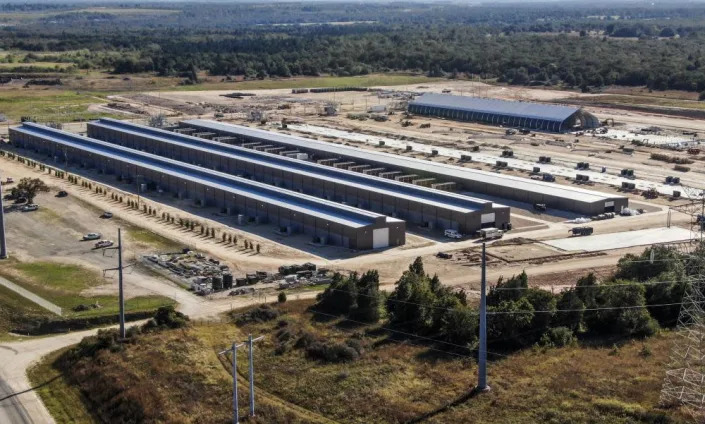Energy use from US cryptomining firms is contributing to rising utility bills
Dani Anguiano in Los Angeles
Sat, July 16, 2022

The largest US cryptomining companies have the capacity to use as much electricity as nearly every home in Houston, Texas; energy use that is contributing to rising utility bills, according to an investigation by Democratic lawmakers.
Cryptomining is a highly energy intensive process involving the use of specialized computers running constantly to solve complex math problems in order to create new virtual coins.
Related: Trillion-dollar crypto collapse sparks flurry of US lawsuits – who’s to blame?
Energy use in the industry is greater than that of entire countries. The US has become the center of cryptomining after it was banned in China. More than a third of the global computing power dedicated to mining bitcoin, the largest cryptocurrency, comes from the US, Senator Elizabeth Warren and five other Democrats reported in a letter to the Environmental Protection Agency.
“The results of our investigation … are disturbing … revealing that cryptominers are large energy users that account for a significant – and rapidly growing – amount of carbon emissions,” the letter states. “It is imperative that your agencies work together to address the lack of information about cryptomining’s energy use and environmental impacts.”
The congressional Democrats have asked the EPA and the Department of Energy to require cryptominers to disclose emissions and energy use, noting that regulators know little about the full environmental impact of the industry.
The lawmakers solicited information from seven of the largest US cryptomining companies, including Stronghold, Greenidge, Bit Digital, Bitfury, Riot, BitDeer and Marathon, about their energy sources and consumption and the climate impacts of their operations. The data revealed that the industry is using a substantial amount of electricity, ramping up production and creating significant carbon emissions at a time when the US needs to drastically reduce emissions to combat the climate crisis.

Emissions data from three companies, Bit Digital, Greenidge and Stronghold, indicated their operations create 1.6m tons of CO2 annually, an amount produced by nearly 360,000 cars. Their environmental impact is significant despite industry claims about clean energy use and climate commitments, the lawmakers wrote.
“Bitcoin miners are using huge quantities of electricity that could be used for other priority end uses that contribute to our electrification and climate goals, such as replacing home furnaces with heat pumps,” the letter states.
“The current energy use of cryptomining is resulting in large amounts of carbon emissions and other adverse air quality impacts, as well as impacts to the electric grid.”
The power demands of the industry are also coming at a cost to consumers, the letter states, citing a study that found cryptomining operations in upstate New York led to a rise in electric bills by roughly $165m for small businesses and $79m for individuals.
In Texas, which has become a cryptomining hub, the industry is expected to continue to expand significantly in the coming years, increasing the amount of electrical load to nearly a third of the grid’s current maximum capacity over the next four years and straining the system, according to a report from the Verge.
“The more crypto mining that comes into the state, the higher the residents should expect the electricity prices to become,” Eric Hittinger, a professor at Rochester Institute of Technology, told the outlet.
The cryptocurrency market has crashed in recent months, dropping in value from more than $3tn in November 2021 to less than $1tn.

Harri Weber
Fri, July 15, 2022
Citing "disturbing" levels of power used by cryptocurrency miners, a group of Democrats led by Sen. Elizabeth Warren is urging the Environmental Protection Agency and the Department of Energy to crack down on the controversial industry.
The letter, signed by four senators and two representatives, calls on regulators to compel cryptominers to disclose their carbon emissions and energy use. Environmentalists have long raised concerns about Bitcoin and other power-hungry, proof-of-stake tokens — and globally, cryptocurrencies are estimated to consume more energy than entire countries, such as Venezuela and Finland.
In the U.S., just seven firms have built more than 1.045 gigawatts of capacity for cryptomining purposes, the report states. "This is enough capacity to power all the residences in Houston, Texas." The mining farms highlighted in the report are run by Stronghold, Greenidge, Bit Digital, Bitfury, Bitdeer, Marathon and Riot.
Though the crypto winter of 2022 might incentivize some miners to scale back operations, the lawmakers argue the industry at large is poised to grow rapidly and "is likely to be problematic for energy and emissions." Still, they caution that "little is known about the full scope of cryptomining activity." Hence their call for more data.
In response to the lawmakers, the companies downplayed the industry as a source of planet-cooking emissions. Nevertheless, they highlighted their individual efforts to curtail emissions and tap into renewable sources.
Marathon pointed to its work "with energy companies to build clean, green, renewable energy resources (e.g., solar and wind) that might not otherwise be built." However, most of the energy tapped by Marathon currently comes from a coal-burning plant in Hardin, Montana.
Along similar lines, Riot argued that "Bitcoin mining drives more demand for renewable energy than the typical U.S. energy consumer" and spotlighted its use of hydroelectricity in upstate New York. Riot's operations in Rockdale, Texas, however, feature nearly seven times the capacity and draw power from the state grid. Texas generated most of its energy from nonrenewable sources last year (51% from natural gas and 13.4% from coal).
Speaking of coal, Stronghold told lawmakers that it is "actively working to remediate coal refuse piles and converting coal refuse into energy." Coal mining waste is an environmental nightmare, and cleaning it up is a good idea. Burning coal waste, on the other hand, still yields harmful emissions, though scrubbers can lessen the worst effects.
Blockfusion and Bitdeer, meanwhile, pointed to their use of software to minimize strain on energy grids.
Though the letter casts a critical eye on crypto, the majority of near-term emissions cuts in the U.S. need to come from the power and transportation sectors in order for the U.S. to reach its 2030 net emissions goal, according to researchers at the Electric Power Research Institute. In April last year, the White House said it aimed to halve U.S. greenhouse gas emissions by 2030.
D.C. remains virtually deadlocked on climate legislation, yet Democratic lawmakers (those not named, Sen. Joe Manchin) have sought to curtail emissions via tax credits, which could juice both renewable energy generation and electric car sales. In a June interview with TechCrunch, Energy Secretary Jennifer Granholm said passing clean-energy tax credits this summer was "the most certain path" for the U.S. to follow.
No comments:
Post a Comment